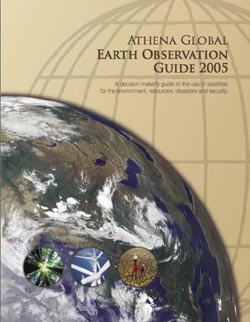|
|
Review: Athena Global Earth Observation Guide 2005
by Jeff Foust
Monday, July 10, 2006
Athena Global Earth Observation Guide 2005
by Andrew Eddy et al.
Athena Global, 2005
softcover, 256 pp., illus.
ISBN 0-9737106-0-8
US$600
When the publishers of the Athena Global Earth Observation Guide 2005, an international consulting group headquartered in Montreal, contacted me earlier this year about reviewing this book, I cautioned them that most readers of this publication would be unlikely to afford the book, which cost $1,200 when released last year. (While nearly two orders of magnitude more expensive than a typical mass-market book, such prices are not unusual for in-depth professional reports.) However, they said that wasn’t a problem, and added that the book’s price had since been cut in half. While at $600 this is still not an inexpensive book, it does prove to be a very useful guide for anyone interested in how remote sensing—arguably the second-biggest space application next to communications—is used throughout the world.
Athena Global Earth Observation Guide 2005 starts, after a brief introduction to remote sensing technologies, with three “theme papers” on the various uses of space-based remote sensing: studies of the environment, identification of natural resources, and disaster management and security uses. The bulk of the book provides a global examination of the various uses of remote sensing on a region-by-region, and country-by-country, basis. This includes not just the “usual suspects”—countries like the US, Russia, China, and France, which have their own satellite platforms for collecting Earth imagery—but also smaller countries that either have very limited space assets (such as Taiwan, which has the ROCSAT, aka Formosat, series of spacecraft) or none at all. The result is a comprehensive look at which countries are using remote sensing data, and for what applications.
| While not an inexpensive book, it does prove to be a very useful guide for anyone interested in how remote sensing—arguably the second-biggest space application next to communications—is used throughout the world. |
Because of the focus on remote sensing applications, one fault with Athena Global Earth Observation Guide 2005 is that it’s more difficult to find information on remote sensing spacecraft. There is some discussion of various spacecraft in the country sections, as well as a table in the front of the book where various classes of spacecraft are judged on their ability to serve various applications, and a schedule for launches of remote sensing spacecraft currently under development. However, a section devoted to descriptions of existing (and planned) spacecraft, their sensors, and overall capabilities, would have been a useful addition to the book.
Clearly, this book is not for everyone, especially with its $600 price tag. However, for those who involved in remote sensing in some way, either as users of remote sensing data or developers of spacecraft, instruments, or other applications, this book is a useful (and beautifully designed, with full-color illustrations throughout) guide to the current state of the field.
Jeff Foust (jeff@thespacereview.com) is the editor and publisher of The Space Review. He also operates the Spacetoday.net web site and the Space Politics and Personal Spaceflight weblogs. Views and opinions expressed in this article are those of the author alone, and do not represent the official positions of any organization or company, including the Futron Corporation, the author’s employer.
|
|
